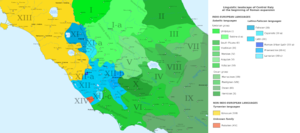Loading AI tools
Language family From Wikipedia, the free encyclopedia
The Latino-Faliscan or Latinian languages form a group of the Italic languages within the Indo-European family. They were spoken by the Latino-Faliscan people of Italy who lived there from the early 1st millennium BCE.
| Latino-Faliscan | |
|---|---|
| Latinian | |
| Geographic distribution | Originally Latium in Italy, then throughout the Roman Empire, especially in the western regions; now also throughout Latin America, Eastern Canada, and many countries in Africa |
| Linguistic classification | Indo-European
|
| Proto-language | Proto-Latino-Faliscan |
| Subdivisions |
|
| Language codes | |
| Glottolog | lati1262 |
 Latino-Faliscan languages and dialects in different shades of blue. | |
Latin and Faliscan belong to the group, as well as two others often considered dialects of archaic Latin:[citation needed] Lanuvian and Praenestine.
As the power of Ancient Rome grew, Latin absorbed elements of the other languages and replaced Faliscan. The other variants went extinct as Latin became dominant. Latin in turn developed via Vulgar Latin into the Romance languages, now spoken by more than 800 million people, largely as a result of the influence of the Roman Empire initially, and in later times the Spanish, French and Portuguese Empires.
Latin and Faliscan have several features in common with other Italic languages:
Latin and Faliscan also have characteristics not shared by other branches of Italic. They retain the Indo-European labiovelars /*kʷ, *gʷ/ as qu-, gu- (later becoming velar and semivocal), whereas in Osco-Umbrian they become labial p, b. Latin and Faliscan use the ablative suffix -d, seen in med ("me", ablative), which is absent in Osco-Umbrian. In addition, Latin displays evolution of ou into ū, though this happens later than the Latino-Faliscan era, occurring around the 2nd century BCE (Latin lūna < Proto-Italic *louksnā < PIE *lówksneh₂ "moon").
It is likely that the consonant inventory of Proto-Latino-Faliscan was basically identical to that of archaic Latin. Consonants not found in the Praeneste fibula are marked with an asterisk.
The /kʷ/ sound still existed in archaic Latin when the Latin alphabet was developed, since it gives rise to the minimal pair quī /kʷiː/ ("who", nominative) > cuī /ku.iː/ ("to whom", dative). In other positions there is no distinction between diphthongs and hiatuses: for example, persuādere ("to persuade") is a diphthong but sua ("his"/"her") is a hiatus. For reasons of symmetry, it is quite possible that many sequences of gu in archaic Latin in fact represent a voiced labiovelar /gʷ/.[citation needed]
Seamless Wikipedia browsing. On steroids.
Every time you click a link to Wikipedia, Wiktionary or Wikiquote in your browser's search results, it will show the modern Wikiwand interface.
Wikiwand extension is a five stars, simple, with minimum permission required to keep your browsing private, safe and transparent.